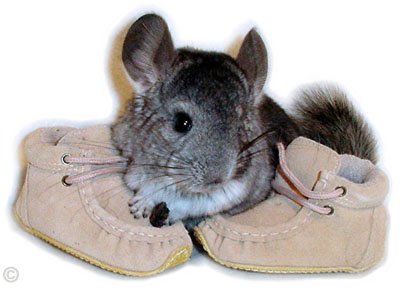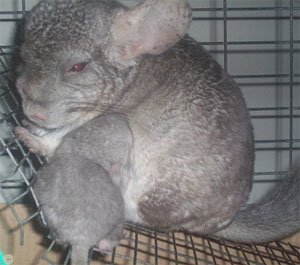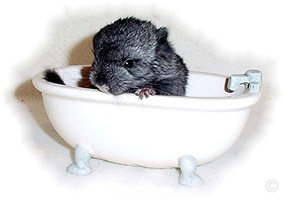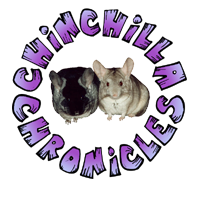 Chinchilla babies are known as 'kits'. A healthy chinchilla kit is born fully able with its eyes open, body covered in fur and all 20 teeth present.
Chinchilla babies are known as 'kits'. A healthy chinchilla kit is born fully able with its eyes open, body covered in fur and all 20 teeth present.
A newborn healthy chinchilla baby/kit weighs between 35-60 grams and reaches its full size within 18 - 24 months (although some kits will continue to develop until they are 3 - 4 years old). Chinchilla babies/kits that are born under 25 grams are generally classed as weak and have a lessened chance of survival if no interaction takes place.
When born, a kit is wet and must be dry within the first hour of birth to prevent cooling or worse, death.
It is essential to observe the weight of a new born kit over the first few weeks, especially if there are more than two born, as a kit who is not feeding from the mother accordingly can die of malnutrition. Generally chinchilla kits will be feeding from their ‘chin-mum’ within 1 hour of birth and a newborn should put on between 5-10 grams of weight per week.
Chinchilla kits can be quite aggressive towards their siblings and especially when it’s mealtime. Weaker kits are generally trampled on or pushed away by siblings therefore it is a good idea to weight kits on a twice weekly basis to ensure they are gaining good weight. Any kit that is not gaining weight accordingly will need extra hand-feeding until they have reached the required size and any kit that is gaining too much weight will need partial restraining at mealtimes. If either of the above situations are ignored a chinchilla baby can die!
The cause of death from both 'over' and 'under' eating is due to acute indigestion, resulting from the pyloris, or lower portion of the stomach, becoming closed. You may need to hold one of the young siblings back so that he/she will not take too much milk and let the others have nourishment before the mammary glands of the female become empty by the previous kit over feeding.
 WARNING - If the litter is large, or the milk supply is inadequate to satisfy all the kits, the females mammary glands can become quite sore. Chinchilla kits have very sharp teeth and can easily cause abrasions to the female's teats. The pain can cause the female to suddenly bite her offspring, which can prove fatal if her teeth penetrate a vital spot such as the liver or brain. Some kits, as a result of being bit, may die a day or so later if their wounds are not in a vital area but have not been properly treated. Chinchilla babies that have been bitten in such a way will become dull, listless and not suckle at feeding times. They will remain isolated away from the female and the rest of the litter and will be observed sitting hunched up in the cage. The young kit will become cold, hungry and weak and will soon die if attention and hand feeding is not provided immediately.
WARNING - If the litter is large, or the milk supply is inadequate to satisfy all the kits, the females mammary glands can become quite sore. Chinchilla kits have very sharp teeth and can easily cause abrasions to the female's teats. The pain can cause the female to suddenly bite her offspring, which can prove fatal if her teeth penetrate a vital spot such as the liver or brain. Some kits, as a result of being bit, may die a day or so later if their wounds are not in a vital area but have not been properly treated. Chinchilla babies that have been bitten in such a way will become dull, listless and not suckle at feeding times. They will remain isolated away from the female and the rest of the litter and will be observed sitting hunched up in the cage. The young kit will become cold, hungry and weak and will soon die if attention and hand feeding is not provided immediately.
If you are ever going to lose a kit it will generally be within the first week of birth (unless interaction is made) and a good indication of the kit's health (in its first few days) is by its tail. A newborn kit’s tail will be straight initially, dragging along the floor but after 12 hours, the tail should start to curl. After 48 hours the kit’s tail should curl right up into the air. This is a positive sign that the kit is feeding appropriately and is in good health.
 A new born chinchilla kit should only feed on milk and it is not until the 4th week that they should be allowed to nibble on small amounts of hay and chinchilla pellets. It is seriously important not to over feed a newborn kit as they can potentially die due to their sensitive gastrointestinal tract adjusting to food alterations.
A new born chinchilla kit should only feed on milk and it is not until the 4th week that they should be allowed to nibble on small amounts of hay and chinchilla pellets. It is seriously important not to over feed a newborn kit as they can potentially die due to their sensitive gastrointestinal tract adjusting to food alterations.
Around the 8th week a chinchilla kit will be consuming between ½ - ¾ tablespoons of pellets per day together with a small amount of hay. Never feed a kit a ‘chinchilla mix’ food, they should only consume pellets made for chinchillas, good quality coarse hay and eventually water. Saying this, you should never give a chinchilla of any age a food-mix as this will cause them to be picky and miss out the pellets that are vital to their nutrition.
It is a good idea to handle kits on a regular basis if they are to get used to human contact and also perform an examination to check on health developments. You must be careful when handling a chinchilla kit for two reasons - firstly, kits have tiny bones that can easily break if manhandled and secondly they are quick with no concept of height and can easily jump from your hands falling onto a hard floor (causing injury or death!).
The ears, eyelids, nose, mouth, feet and the entire body of a chinchilla baby should be examined frequently not just for weight gain but for the presence of small bites and abrasions. These can be caused by the chin-mum biting the offspring or from bites and scratches received from fighting siblings. Should any minor abrasions be noted, the wound should be cleaned with warm saline solution before gently applying some mild antiseptic ointment. If any wound looks severe or is not healing in good time a chinchilla kit must be taken to a veterinary surgeon for further examination and treatment.
A chinchilla kit will learn from its mother and this goes for grooming and using a dust bath. A dust bath can be provided to both the chin-mum and her kits when the chin-mum uterus has closed after the birth, thus preventing any infections.
A kit is classed mature at approximately 1 year of age. A young female can mate as young as 3 - 4 months of age but they often begin any time between 6 - 24 months. It is imperative that kits are weaned from the maternal cage no later than 12 weeks of age to prevent inter-breeding, which is highly discouraged due to potential deformities and severe health issues.
 Ailments In Chinchilla Kits
Ailments In Chinchilla Kits
The most common ailments in chinchilla kits are:
- Sore Eyes
- Body Temperature Variations
- Conjunctivitis
- Constipation & Diarrhoea
- Indigestion
- Injuries
Sore Eyes - Generally a result from scratches and abrasions, a foreign substance entering the eye socket, strong lighting and bad bacteria. Must be treated immediately using a saline solution and should an infection be noted an antibiotic eye treatment will be necessary to prevent further deterioration leading to blindness.
Temperature Variations - Extreme temperatures are dangerous and allowing a baby chinchilla to become chilled or cold soon after they are born is the greatest cause of loss than any other known factor. Draughts are also dangerous and the cage and nest box must be checked regularly to ensure they are in an environment with a constant room temperature between 60°-75°F (15.5°-25°C).
Conjunctivitis - Acute inflammation of the outer layer of the eyeball and the inner surface of the eyelid mainly caused by viral infections and bacteria entering the eye socket. Can be treated with antibiotic eye drops and cleansed regularly with a warm saline solution.
Constipation & Diarrhoea - These ailments are both caused by the feed the chinchilla kit is receiving. Kits begin to eat their parents food (hay and pellets) after a couple of days if allowed but their digestive tracts cannot break down the coarse fibre and hard pellets, which can lead to hard or sludgy faeces. Chinchilla pellets should be positioned high up in the cage and securely fastened so the food bowl cannot crash down on kits below causing infant mortality. Also ensure the kits are unable to climb onto high levels to try and follow their parent as they have no comprehension of height and will fall great heights if able to do so.
Indigestion - A common ailment in kits caused by over feeding and over loading of the stomach. The condition is more common in kits that are hand fed than those that are suckling from their mother's milk. If the kit is being hand fed then regulate the amount of feed that is being given.
Injuries - It is not infrequent that a kit will injury itself shortly after birth and is mainly due to the owners neglect in preparations for the birth and the cage environment. The kits can also be tramped on by overly eager siblings or a adult male chasing the female around the cage to re-mate.
The Chinchilla A-Z Health & Sickness Bible is an excellent ebook that covers over 150+ different illnesses a chinchilla can acquire from birth and throughout its lifetime. This amazing ebook is like no other chinchilla book currently on the market and explains in full detail the ailment together with the 'cure' for various disease and illnesses! An invaluable source for any chinchilla owner, especially one with a chinchilla kit to care for! Read More...
Further Reading Relating To Chinchilla Babies/Kits:
Birth, Breeding Chinchillas, Genetics, Hand Feeding, Male Castration, Nutrition (Food & Diet), Pregnancy, Weaning A Chinchilla Kit.


 Chinchilla babies are known as 'kits'. A healthy chinchilla kit is born fully able with its eyes open, body covered in fur and all 20 teeth present.
Chinchilla babies are known as 'kits'. A healthy chinchilla kit is born fully able with its eyes open, body covered in fur and all 20 teeth present. WARNING - If the litter is large, or the milk supply is inadequate to satisfy all the kits, the females mammary glands can become quite sore. Chinchilla kits have very sharp teeth and can easily cause abrasions to the female's teats. The pain can cause the female to suddenly bite her offspring, which can prove fatal if her teeth penetrate a vital spot such as the liver or brain. Some kits, as a result of being bit, may die a day or so later if their wounds are not in a vital area but have not been properly treated. Chinchilla babies that have been bitten in such a way will become dull, listless and not suckle at feeding times. They will remain isolated away from the female and the rest of the litter and will be observed sitting hunched up in the cage. The young kit will become cold, hungry and weak and will soon die if attention and hand feeding is not provided immediately.
WARNING - If the litter is large, or the milk supply is inadequate to satisfy all the kits, the females mammary glands can become quite sore. Chinchilla kits have very sharp teeth and can easily cause abrasions to the female's teats. The pain can cause the female to suddenly bite her offspring, which can prove fatal if her teeth penetrate a vital spot such as the liver or brain. Some kits, as a result of being bit, may die a day or so later if their wounds are not in a vital area but have not been properly treated. Chinchilla babies that have been bitten in such a way will become dull, listless and not suckle at feeding times. They will remain isolated away from the female and the rest of the litter and will be observed sitting hunched up in the cage. The young kit will become cold, hungry and weak and will soon die if attention and hand feeding is not provided immediately. A new born chinchilla kit should only feed on milk and it is not until the 4th week that they should be allowed to nibble on small amounts of hay and chinchilla pellets. It is seriously important not to over feed a newborn kit as they can potentially die due to their sensitive gastrointestinal tract adjusting to food alterations.
A new born chinchilla kit should only feed on milk and it is not until the 4th week that they should be allowed to nibble on small amounts of hay and chinchilla pellets. It is seriously important not to over feed a newborn kit as they can potentially die due to their sensitive gastrointestinal tract adjusting to food alterations.